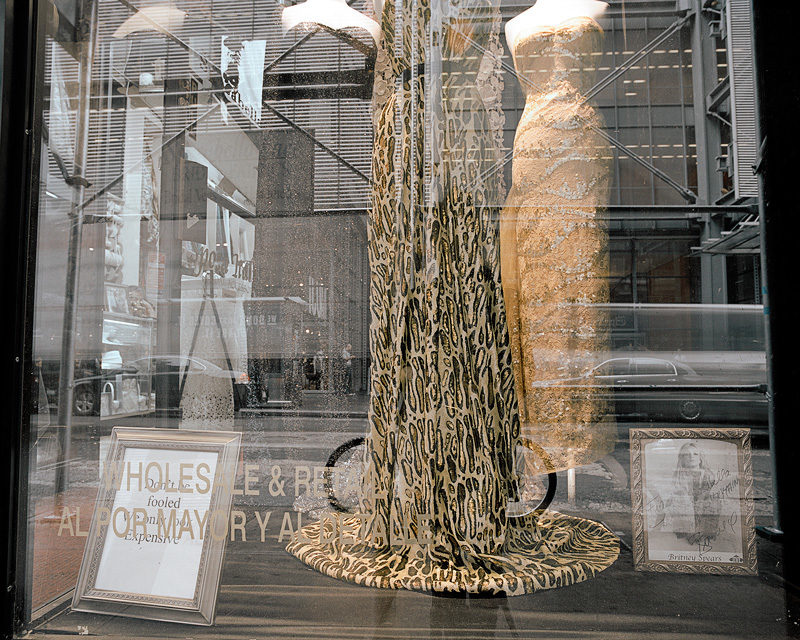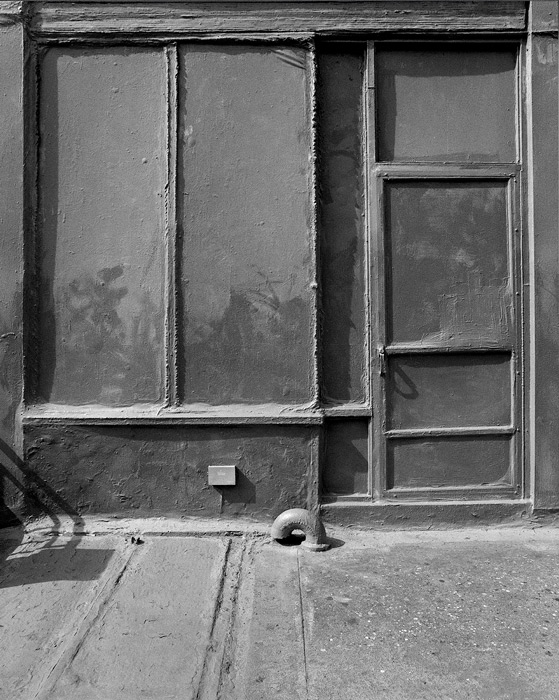Galerie Nicolas Robert, Montreal
24 November 2012 to 19 January 2013
By Stephen Horne
The title of Lorna Bauer’s exhibition at Galerie Nicolas Robert offers a simple paradigm for what she explores with her series of photographs. Bauer initially sets us up for a documentary-style tour of some storefronts in New York’s celebrated garment district. Storefronts have been a tried-and-true subject for photographers since the early days of the technology, thus tying it to the project of modernist aesthetics and a model of rationalist criticality.
Many of the fabrics in these storefronts have decorative floral or geometric patterns; that is, they resemble modernist abstractions. These are not subjects of documentary interest but contribute to the overall sense of reflection and refraction that make up a particular temporal experience. In 41 Street, for example, a window with layers of reflection projects aspects of the street scene behind the photographer into a space in which we see, mingling with the bolts of patterned fabrics, a parked scooter with the mirage of a chair inside the store. If we take this hybrid mix of the actual and the virtual, the inside and the outside, to be spatial confusion, this is so only in relation to time understood according to the convention of linear, historical evolution. In this sense, the photograph documents or illustrates a scene in the past, an endpoint. However, when looked at freed from the demand of historical consciousness, a photograph becomes a window to the future, a projection and not a record of a past event, a beginning rather than a terminus. Bauer has reinforced this disruption of convention in her piece titled Bracket, composed of two sets of three images. Each of the trios of the “same” scene is presented through three different densities: light, medium, and dark. If we return to the title, “Grey Is a Colour, Gray Is a Color,” we note that Bauer is identifying two different systems for spelling words, presenting the Canadian and American spellings of the words “grey/gray” and “colour/color.”
In Anglophone Canada – at the Globe and Mail, for example – the “e” is used rather than the “a” of standard American usage. This is apparently true for the Anglophone world in general, with the United States being the exception. We could then say that this differential signals a difference; it functions as a codification. Or, we could call it a projection, an action with a futural effect; it’s performative, it enacts the difference it’s referring to, its rehearsal/repetition makes it be so. We could see that this model applies equally well to the situation of language in general. There is nothing essential about using either “e” or “a” – it’s a matter of its doing, its enactment.
For example, in Bracket, the trios are of three kinds of grey – or is it gray? They were, after all, photographed in the United States. And so Bauer proposes some questions about the nature of veracity in photographs – the potential of any photograph to operate as evidence. If all three grey/gray photographs are equally true to life, this would mean that the historical accuracy and reliability of photographs rests on an essentialism – in this case, that the grey/gray window that she has photographed has a true and real grey/gray, we just don’t know which it is, and so photography’s function as record is undermined. The grey/gray of Bauer’s storefront in three alternate versions is just that, three alternatives, all perhaps equally viable. This suggests that our apprehension of reality and truth is a matter of convention and the belief that convention entails. However, this leaves aside the dilemma of invention; can there be invention without convention, or are these two sides of one coin?
Bauer has inflected her apparent subject matter with an important detour; we are confronted not with images recording past moments but with windows becoming screens on which appear both reflections and projections of further screens. By “screens” in this case I mean the peculiar, active spatiality of windows and the interplay of these that make up not a fixed image but a perpetually emergent perception, futural rather than historical. The claim that Bauer makes is actually counter-Barthian, the photograph not as “that has been” but as “this will be.” This gives a very different sense to her image of a storefront, crowded with scrolled dressmaking fabrics, with its handwritten sign inviting us to “come in.”
The photograph from this perspective does not describe or document anything; it rests on nothing, a void, if we are thinking in terms of recording a past/passing. This could be seen as a virtue, this “resting on nothing.” It is counter-foundational, post-historical, and anti-essentialist. Contrarily, it also invites us to acknowledge the power of convention in belief and the role of belief in convention. That is, to the extent that convention works, it is because we believe in it. In this sense, convention is not mere repetition but an enactment of social interaction.
Finally, Bauer’s photographs ask a simple question; why do we speak of taking a photograph? Does the act of taking not also imply a having? We take in order to have.
Stephen Horne is an independent curator and writer living in Montreal and France. He has taught at NSCAD and Concordia Universities and is published in periodicals, catalogues, and anthologies in Canada and elsewhere.


